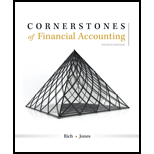
Cornerstones of Financial Accounting - With CengageNow
4th Edition
ISBN: 9781337760959
Author: Rich
Publisher: CENGAGE L
expand_more
expand_more
format_list_bulleted
Concept explainers
Question
Chapter A3, Problem 3CE
To determine
Concept introduction:
Time value of money:
Time value of money is the concept that differentiates the value of money received today and the value of same money received in future. According to this concept, the same amount of money to be received in future shall have lower present value (value of the money today) due to the interest that could be earned on that money.
To calculate:
The Present value of future cash receipts.
Expert Solution & Answer
Want to see the full answer?
Check out a sample textbook solution
Students have asked these similar questions
I am searching for the correct answer to this general accounting problem with proper accounting rules.
Hi expert please help me this question
Calculate the predetermined overhead rate base on direct labor hour?
Chapter A3 Solutions
Cornerstones of Financial Accounting - With CengageNow
Ch. A3 - Prob. 1DQCh. A3 - Prob. 2DQCh. A3 - Prob. 3DQCh. A3 - Prob. 4DQCh. A3 - Prob. 5DQCh. A3 - Prob. 1CECh. A3 - Prob. 2CECh. A3 - Prob. 3CECh. A3 - Prob. 4CECh. A3 - Prob. 5CE
Ch. A3 - Use Future Value and Present Value Tables to Apply...Ch. A3 - Prob. 7CECh. A3 - Prob. 8CECh. A3 - Prob. 9CECh. A3 - Prob. 10CECh. A3 - Prob. 11ECh. A3 - Prob. 12ECh. A3 - Prob. 13ECh. A3 - Future Values and Long-Term Investments Portman...Ch. A3 - Prob. 15ECh. A3 - Prob. 16ECh. A3 - Prob. 17ECh. A3 - Present Values Phillips Enterprises signed notes...Ch. A3 - Present Values Krista Kellman has an opportunity...Ch. A3 - Prob. 20ECh. A3 - Prob. 21ECh. A3 - Future Value of a Single Cash Flow Jenkins...Ch. A3 - Prob. 23ECh. A3 - Installment Sale Baileys Billiards sold a pool...
Knowledge Booster
Learn more about
Need a deep-dive on the concept behind this application? Look no further. Learn more about this topic, accounting and related others by exploring similar questions and additional content below.Similar questions
- Accounting?arrow_forwardCan you help me solve this general accounting question using valid accounting techniques?arrow_forwardMerchandise is soldon account to a customer for $82,500, terms GEB shipping point, 3/10, n/30. The seller paid the freight of $6,300. Determine the amount of the sale.arrow_forward
- Uzo Haulers Co. is a company that manufactures industrial trucks. During the year, Uzo purchased $1,200,000 of direct materials and placed $1,275,000 worth of direct materials into production. Uzo’s beginning balance in the Materials Inventory account was $310,000. What is the ending balance in Uzo’s Materials Inventory account?arrow_forwardPlease show me the valid approach to solving this financial accounting problem with correct methods.arrow_forwardWhat is the cost of goods sold for the company ?arrow_forward
- Compute the percentage of total return on these financial accounting questionarrow_forwardPlease provide the accurate answer to this general accounting problem using appropriate methods.arrow_forwardAccurate Value Hardware began in 2019 with a credit balance of $87,000in the allowance for sales returns account. Sales and cash collections from customers during the year were $963,000 and $715,000, respectively. Accurate Value estimates that 7.5% of all sales will be returned. In 2019, customers returned merchandise for a credit of $36,000 to their accounts. Accurate Value's 2019 income statement would report net sales of__.arrow_forward
arrow_back_ios
SEE MORE QUESTIONS
arrow_forward_ios
Recommended textbooks for you
 Cornerstones of Financial AccountingAccountingISBN:9781337690881Author:Jay Rich, Jeff JonesPublisher:Cengage LearningPrinciples of Accounting Volume 2AccountingISBN:9781947172609Author:OpenStaxPublisher:OpenStax College
Cornerstones of Financial AccountingAccountingISBN:9781337690881Author:Jay Rich, Jeff JonesPublisher:Cengage LearningPrinciples of Accounting Volume 2AccountingISBN:9781947172609Author:OpenStaxPublisher:OpenStax College

Cornerstones of Financial Accounting
Accounting
ISBN:9781337690881
Author:Jay Rich, Jeff Jones
Publisher:Cengage Learning

Principles of Accounting Volume 2
Accounting
ISBN:9781947172609
Author:OpenStax
Publisher:OpenStax College